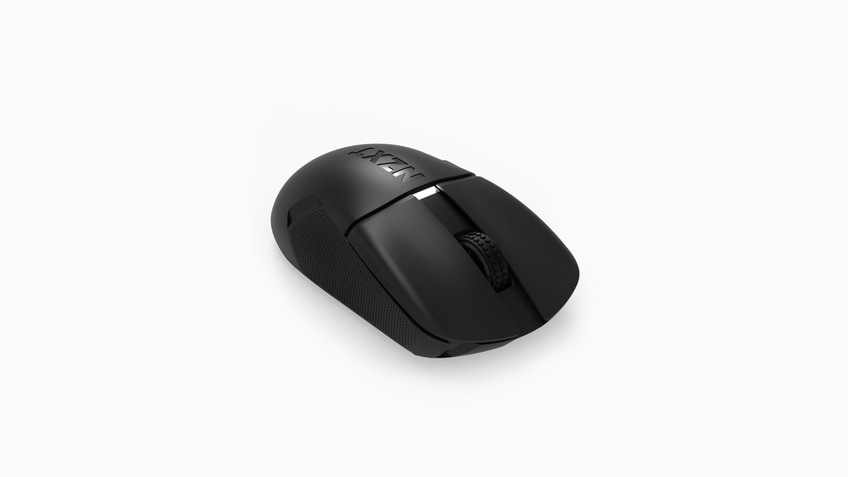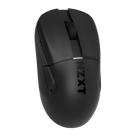Introduction
NZXT has recently launched its Elite lineup of peripherals, which includes a mouse. This newest addition to the Lift line of mice (see our Lift 2 Ergo review) is wireless and comes with optical switches. It is capable of polling rates of up to 4000Hz in wireless mode and 8000Hz in wired mode. Sporting a lightweight, flat design, it could be a great option for gamers who prefer a neutral mouse. In our full NZXT Lift Elite review, we’ll find out if it’s worth your time and money.
At A Glance
NZXT Lift Elite
Used by 1 player ()The NZXT Lift Elite is a decent modern day ‘egg mouse’. If you like that kind of shape (and you can live with the mushier clicks and slightly scratchy feet) and you want to try a lightweight and modern version of it, then this could be a good bet for you.
Pros
- Good build quality
- Good scroll wheel
- Nice coating
Cons
- Feet feel a bit scratchy on some pads
- Main buttons feel a bit mushy due to a combination of post travel and post-click wobble
- Back side button feels spongy and travels inside the shell when pressed at the edges
Specs
| Sensor | PMW 3395 |
|---|---|
| Polling Rate | 250 / 500 / 1000 / 2000 / 4000 / 8000 Hz |
| Button Switches | Optical Switches |
| Button Force | 75.6g |
| Connection | Wireless |
| Shape | Ambidextrous |
| Length | 11.8cm |
| Height | 3.8cm |
| Weight | 57g |
| Width | 6.0cm |
First Impressions
Packaging
Inside the box of the NZXT Lift 2 Elite, you will find:
- The mouse
- USB dongle
- Dongle extender
- USB-C charging cable
- Optional grip tape
The grip tape is only for the main buttons, since the sides already have grip elements on them by default.
It would be nice to also see a set of replacement mouse feet in the box, but that’s not something that very many brands add, so I won’t hold this omission against NZXT.
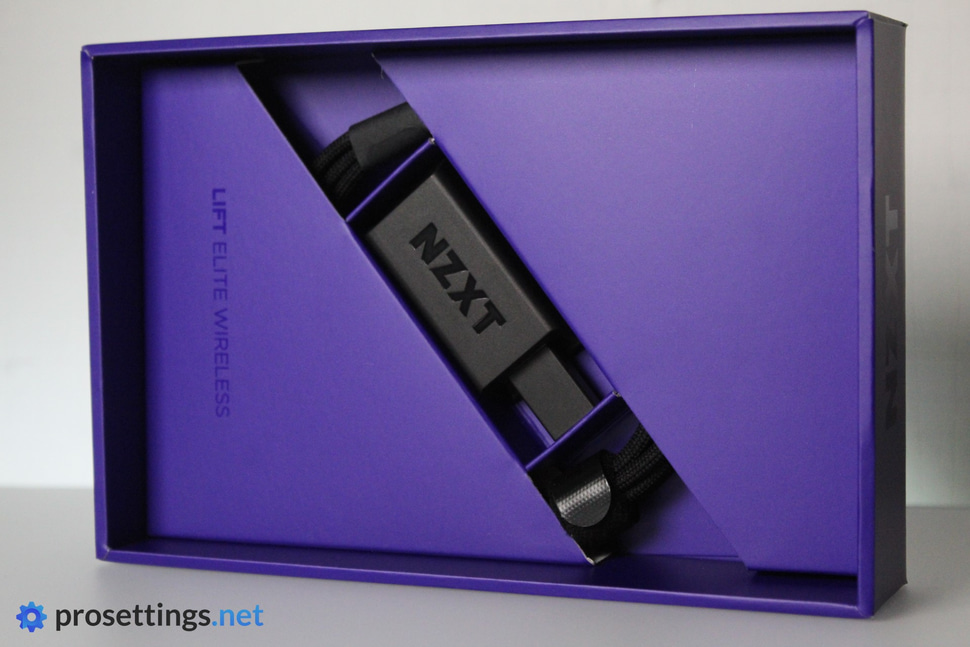
The Mouse
The first thing I noticed about the NZXT Lift Elite is the shape. This mouse is significantly more ‘egg-shaped’ than either the Lift 2 Ergo or Symm. I think this could be a good move since this type of shape has been somewhat neglected by the majority of mainstream brands, but if you liked their previous shapes you might feel a bit disappointed here.
Another thing that caught my eye almost instantly are the sides. Here, NZXT has opted to add rubberized elements. These cannot be removed, so if you’re not a fan of those you might want to steer clear. I’ll elaborate further on the shape and the sides further down in the review though.
In a general sense, the mouse is somewhat of a departure from NZXT’s regular design direction if you ask me. The Lift Elite looks a bit more ‘gamery’ than their previous mice, and is -in my opinion- a minor departure from their usual minimalist aesthetics. There’s the cutout at the back, the open bottom, and then there’s also a quite large debossed NZXT logo on the top. All of this makes for a mouse that’s a little more flashy than their previous ones. Whether you like that or not is, of course, a matter of preference.

Shape, Coating, and Mouse Feet
My hands are 18×10.5cm and I use a normal (neither relaxed, nor aggressive) claw grip.
Shape
The in-hand feeling of the Lift Elite reminds me of egg-shaped mice like the Logitech G305 and the Razer Orochi V2, but there are some clear differences. For starters, the Lift Elite doesn’t really taper towards the front. Instead, its shape goes outward ever so slightly. This difference is extremely small, so the mouse feels as if it has flat sides at the bottom. There is quite a noticeable overhang at the top though, which greatly helps with picking up the mouse.
At the back of the mouse, there’s a very gentle outward curve. This curve is more noticeable than the one at the front, but it’s still not something that’ll draw a lot of attention when holding the mouse due to how subtle it is.
The only section of the mouse that has obvious curves is the very front, where there are some rather pronounced comfort grooves on the main buttons.
The neutral and flat feeling that the Lift Elite offers is further amplified by the hump. This hump is very central, and that combined with the short length of the mouse makes it so that there’s a ton of room between your palm and the mouse. If you like this type of nimble and maneuverable shape, then this should be right up your alley. However, if you want any kind of palm contact, it’s best to leave this one on the shelf.
This type of shape is not for me (I prefer curvier mice in general) but as a neutral design, this is well-done. The slight outward curves and overhang make it feel a bit more stable and locked in than a traditional ‘egg mouse’, which is a nice touch. If you like flat-sided and neutral mice then you’ll probably love this.

Coating
The main coating of the mouse is matte and rather heavily textured. It handles fingerprints and oils really well and it provides a good amount of grip under most circumstances. With that said, most of the actual gripping will be done on the sides, where there are rubber elements.
Rubber sides aren’t a must for me, but I generally like it when they’re on a mouse. These feel good and -obviously- provide a boost to the overall grip security of the mouse.
I know that a lot of people don’t like rubber grips, but with these flat sides I feel like they do provide some extra value. For me, they feel like a natural and logical inclusion rather than a simple aesthetic choice.
Mouse Feet
On the (exposed) bottom of the mouse you’ll see two PTFE feet and a sensor ring. Sadly, they’re a bit scratchy. Not to the extent that they become bothersome (at least not on my unit) but there’s room for improvement here. The feet are also quite thin. If you play on softer pads and you apply a lot of pressure, you might experience frame drag when swiping.
If you like a buttery smooth glide and/or you use soft pads, you’ll want to apply some aftermarket feet.
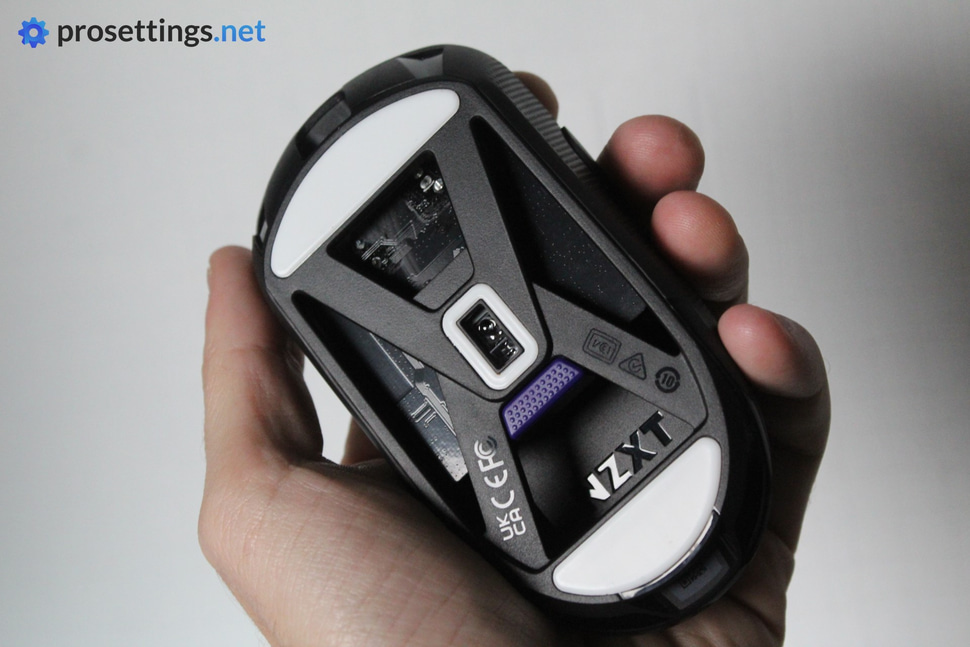
Recommended Grip Types
The NZXT Lift Elite is a neutral mouse that’s on the smaller side. I would say that it’s great for fingertip users of all hand sizes as well as small to medium-sized claw grippers. Due to the shape and overall size, I wouldn’t necessarily recommend this as a palm grip mouse.
With that said: this is just a guideline. Everyone has different preferences, so take this section as guidance, not as gospel.
Buttons and Scroll Wheel
Buttons
Underneath the main buttons, NZXT has used TTC Optical switches. These feel good to use in a vacuum, but they’re not as crispy as they can be due to some flaws with the implementation of the main buttons.
Unfortunately, both buttons have excessive post-click travel. There’s also some minor wobbling if you keep a button pressed down and shift your finger a bit, making the post travel more noticeable. When combined, these small flaws make it so that the main clicks feel a lot mushier than they perhaps could feel.
Aside from this, there’s no excessive side movement, nor is there any switch grinding. Pre travel is also spot on. If NZXT manages to reduce the post travel and the wobble in following batches, these clicks would feel good. Right now they’re just kind of ‘okay’.

Side Buttons
The front button feels fine to use. There’s no excessive (post or pre) travel and the button actuates with a nice click. The back button feels noticeable spongier, and that’s due to the ‘pivot problem’ that many side buttons suffer from.
As long as you press it lightly, it feels okay. Perhaps slightly mushy, but fine otherwise. However, if you apply any sort of pressure and press it near the edge, you’ll find that you’re pressing the button into the shell. This is something that happens with a lot of side buttons, but it’s particularly noticeable here.
Pressing at the back, I managed to make it travel several millimeters past the actuation point, and that’s without applying ridiculous amounts of pressure. I’m not someone who believes that mice should be able to endure unrealistic amounts of pressure (I’ve never been a fan of the ‘test’ where people apply vice-like pressure to the sides of a mouse to see if they can get a button to actuate for example), so I didn’t go out of my way to abuse the mouse, but the back side button could definitely be reinforced in some way.
Scroll Wheel
This will be a short section because the scroll wheel feels great to me. It’s heavily textured, quiet, and on the more rigid side. These are all things that I like in a scroll wheel, so this gets top marks from me. As a cherry on top, it’s also easy to click without accidentally scrolling.
Build Quality
The build quality on my unit is pretty much perfect. When I vigorously shake the mouse in the air I can hear a faint ticking near the scroll wheel, but that’s not a problem to me at all.
More importantly, applying pressure to the mouse doesn’t reveal any weak points in the shell. Even the thin railings on the exposed bottom feel rigid.
The NZXT Lift Elite feels like a high quality gaming mouse.

Sensor and Everyday Performance
Sensor
Powering the NZXT Lift Elite is the 3395 sensor. That’s perhaps not the hottest sensor on the market right now (that would be the 3950) but it’s a flawless sensor that’s delivering wireless polling rates of up to 4000Hz, so there’s no need to worry about the performance.
In my testing, the sensor performed just as expected. Polling rate stability did fluctuate somewhat, but this is nothing that I noticed when gaming.
As an added bonus, the Lift Elite is capable of polling rates up to 8000Hz when you use it with a wire. I’d personally rather use a mouse wirelessly at 4000Hz than have to deal with a wire at 8000Hz, but of course this is down to personal preference. I also tested the 8000Hz feature and that also works exactly as one would expect. Do note that you need to select the 8000Hz feature in NZXT’s CAM first: the mouse doesn’t go to 8000Hz by default if you plug it in.
All in all, the 3395 sensor seems to have been implemented as it should here.
Configuring The Mouse
Configuring the mouse is done via NZXT’s CAM software. This is a relatively light and easy to use piece of kit, and everything is laid out clearly. Something that I like is that the more ‘in-depth’ settings (such as LOD) have a little ‘more info’ section next to them that you can mouse over. The explanation that you then get is admittedly very short, but things like these go a long way in making performance products easier to use for the average consumer.
Aside from configuring the polling rate and what have you, users can also record macros and rebind mouse buttons in CAM. Everything you’d want to do with a gaming mouse is present here.
The inclusion of 5 onboard profiles also means that you basically only have to configure the mouse once. Changing profiles is done by pressing the purple power button on the bottom of the mouse. Once you’ve created your 5 profiles (I can’t imagine any gamer needing more than that) you can quite simply remove the software altogether.
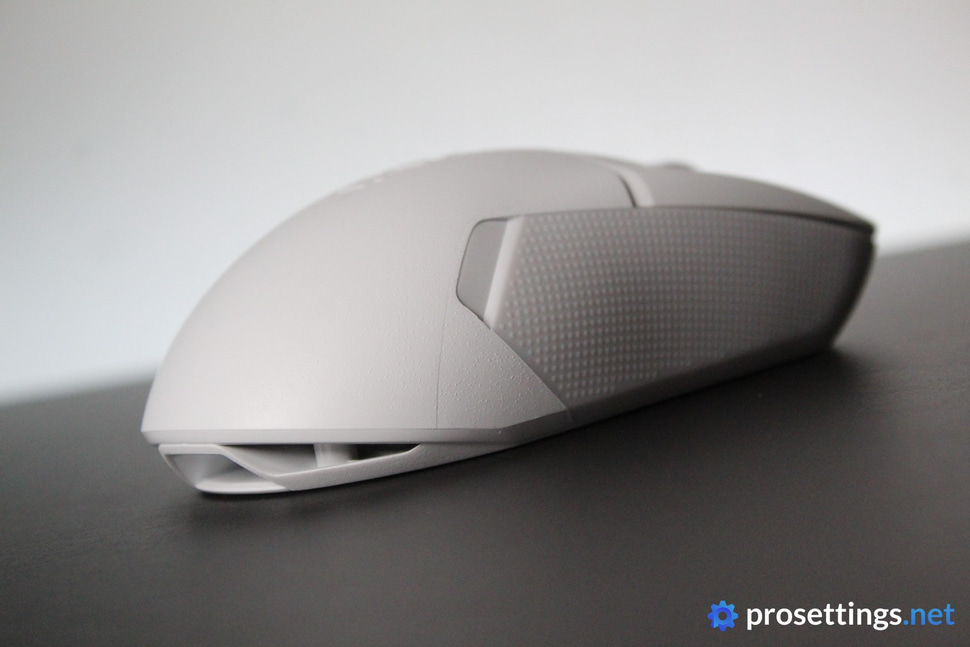
Battery Life
The battery life at 1000Hz sits at 70 ingame hours. That’s not definitely not record-breaking but it is more than enough to get by. When you raise the polling rate, you’ll find yourself without juice quite a bit faster. This isn’t NZXT’s fault; higher polling rates simply consume more power.
Luckily, the included charging cable is meant as a ‘play while charging’ type of cable (since they also advertise the 8000Hz wired feature) and is a relatively flexible and lightweight cable. Should you find yourself in battery trouble, you can always play with the cable attached. I did so during my testing and while I would never go back to using wired mice by default, I’d say that the charging cable felt fine to use.
Alternatively, you could also simply charge the mouse. Just 15 minutes of charging gets you 15 hours of battery at 1000Hz. Even if you play at higher polling rates, a quick charging session during lunch should be enough to get you through the day.
Alternatives
Not many mainstream manufacturers produce mice of this type, so there aren’t a whole bunch of alternatives. If you want a similar experience, you could go for the Logitech G305 or the Razer Orochi V2. Both of these mice use a battery for power though, meaning that you’ll have to buy those. The Logitech G305 is also much older, heavier, and only goes up to 1000Hz. Furthermore, it has mechanical switches, whereas the Lift Elite has opticals.
The Razer Orochi V2 is a more modern alternative with a similar weight. It does come with an older sensor that only goes up to 1000Hz and has mechanical switches though, so specs-wise it’s not as advanced as the NZXT Lift Elite. It’s also more expensive at MSRP.

Conclusion
The NZXT Lift Elite is a decent take on a modern day ‘egg mouse’. If you like that kind of shape (and you can live with the mushier clicks and slightly scratchy feet) and you want to try a lightweight and modern version of it, then this could be a good bet for you.
This mouse feels like NZXT have tried to do their own thing with this type of extremely neutral shape, and I quite like that. It’s not a copy of an existing design, but rather their own version of it. The flat sides combined with the overhang on the front and the rubber sides makes this a lot more usable for me than some of its competitors, so they really had some good ideas here.
Sadly, as mentioned, the execution isn’t all there. The mouse performs exactly as it should in terms of gaming performance, but there are a couple of hiccups (the clicks, the feet, the side buttons) that prevent this from being a top tier choice.
With that said: this mouse costs about half of what most mainstream manufacturers are currently asking for top-specced wireless mice, so if you want to get yourself a great performance deal for a relatively low price, this could be a good choice. It’s a solid mouse with some interesting design choices.
This product was received for free from the manufacturer and given to our reviewer to test and review. Brands and manufacturers have no editorial control over our reviews. For more information, check out our review FAQ.


